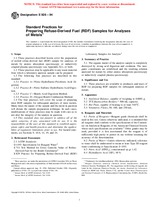We need your consent to use the individual data so that you can see information about your interests, among other things. Click "OK" to give your consent.
ASTM E926-94
Standard Practices for Preparing Refuse-Derived Fuel (RDF) Samples for Analyses of Metals (Withdrawn 2002)
STANDARD published on 1.1.1994
The information about the standard:
Designation standards: ASTM E926-94
Note: WITHDRAWN
Publication date standards: 1.1.1994
SKU: NS-48493
The number of pages: 6
Approximate weight : 18 g (0.04 lbs)
Country: American technical standard
Category: Technical standards ASTM
Annotation of standard text ASTM E926-94 :
Keywords:
Bomb/acid digestion method, ICP-AES (inductively-coupled plasma optical emission spectrometry), Metal content, Nitric-hydrofluoric-perchloric acid digestion, Nitric-sulfuric-hydrofluoric acid digestion, Oxygen bomb method, Resource recovery-solid waste refuse-derived fuel/RDF, Sample preparation-waste materials, Sampling-refuse-derived fuel/RDF, Spectroscopy-atomic absorption, Spectroscopy-inductively coupled plasma (ICP), preparing refuse-derived fuel (RDF) samples for analyses of metals, by
Additional information
| 1. Scope |
|
1.1 These practices described herein cover the preparation of milled refuse-derived fuel (RDF) sample for analyses of metals by atomic absorption spectroscopy or inductively coupled plasma spectroscopy (see Appendix X1), or both. 1.2 These practices may be applicable to any waste material from which a laboratory analysis sample can be prepared. 1.3 The following four practices are described in this standard: 1.3.1 Practice A -Nitric-Hydrofluoric-Perchloric Acid Digestion. 1.3.2 Practice B -Nitric-Sulfuric-Hydrofluoric Acid Digestion. 1.3.3 Practice C -Bomb, Acid Digestion Method. 1.3.4 Practice D -Oxygen Bomb Combustion Method. 1.4 The four practices will cover the scope of preparing most RDF samples for subsequent analyses of most metals. Many times the nature of the sample and the metal in question will dictate the sample preparation technique. In such cases, modifications of these practices may be made with care as to not alter the integrity of the analyte in question. 1.5 This standard does not purport to address all of the safety concerns, if any, associated with its use. It is the responsibility of the user of this standard to establish appropriate safety and health practices and determine the applicability of regulatory limitations prior to use. For hazard statements, see Sections 9, 10.6, 14, 19, and 24. |
We recommend:
Technical standards updating
Do you want to make sure you use only the valid technical standards?
We can offer you a solution which will provide you a monthly overview concerning the updating of standards which you use.
Would you like to know more? Look at this page.




 Cookies
Cookies
